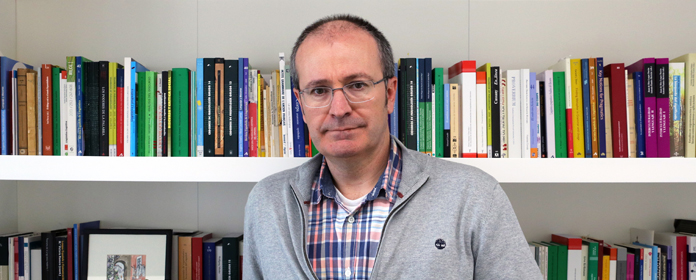“El lenguaje es el corazón de la cultura y la oralidad es un indicativo de que una lengua está viva”
Asier Barandiarán, experto en bertsolarismo, colabora con un proyecto de investigación sobre creatividad y lenguaje oral en el Instituto Cultura y Sociedad de la Universidad de Navarra

FOTO: Natalia Rouzaut
Los géneros orales han estado presentes en todas las culturas, pero la gran mayoría han perdido importancia en la actualidad en favor de la escritura. Una de las grandes excepciones es el bertso, estrofas cantadas e improvisadas en euskera.
Según afirma Asier Barandiaran, profesor del departamento de Didáctica de la Lengua y la Literatura en la Universidad del País Vasco, en la actualidad, “el bertso es un género en pujanza”. Esto se explica por su buena organización –existen instituciones que investigan sobre el bertsolarismo, centros de documentación y escuelas donde se enseñan– además de porque ha sabido unir “tradición y modernidad”, señala.
Para el experto, la oralidad sigue teniendo presencia en la actualidad ya que, gran parte de la información que recibimos, es por medios audiovisuales y no escritos. De hecho, afirma que “el lenguaje es el corazón de la cultura y la oralidad es un indicativo de que una lengua está viva”, pues en la creatividad oral podemos ver “cómo creamos el lenguaje, cómo nos servimos de la tradición, cómo nos servimos de los elementos prefabricados, nuestra capacidad de crear nuevas imágenes, ideas…”.
Conocer cómo puede la mente humana generar manifestaciones tan complejas como las representaciones poéticas orales es el propósito del proyecto ORFORCREA, desarrollado por la investigadora Marie Curie Sarali Gintsburg en el Instituto Cultura y Sociedad de la Universidad de Navarra. Asier Barandiarán se ha unido como colaborador para investigar junto con Sarali las distintas tradiciones orales y las bases cognitivas de la creatividad en el arte verbal.
Entre las tradiciones que abordan, Sarali se ha centrado en la Jbala, una tradición poética oral del norte de Marruecos. “La oralidad tiene una serie de tendencias o pautas que son comunes en las distintas culturas y lenguas –expone Asier– ellas la Jbala”. Ambos expertos coinciden en las similitudes de estas tradiciones: las dos están unidas al mundo tradicional y rural. Además, las estrategias comunicativas, compositivas e, incluso, ciertas técnicas retóricas son bastante parecidas.
Las mujeres y el bertsolarismoLas primeras referencias documentales del bertsolarismo, como lo conocemos actualmente, datan de principios del siglo XIX. Se trataban de interpretaciones orales en plazas y tabernas, muchas veces en forma de competición. Sin embargo, Barandiaran asegura que los primeros testimonios de bertsolarismo improvisado proceden de mujeres que, como por ejemplo los cantos fúnebres de Milia de Lastur (siglo XV) y como en muchas culturas, cantaban improvisando en los funerales.
“En el mundo de la oralidad, en general, la mujer ha tenido un papel muy importante”, indica. Sin embargo, lamenta que, durante los siglos XIX y XX, las mujeres quedaran relegadas a un segundo plano. “A esto se le da la vuelta en las últimas décadas donde, gracias a, por ejemplo, las escuelas de bertsolaris, las mujeres empiezan a tomar parte con normalidad en distintos eventos bertsolarísticos”, añade. De hecho, la campeona actual del bertsolarismo es una mujer, Maialen Lujanbio -quien, por cierto, impartirá una sesión en el ICS el 16 de mayo-.
En sus inicios, los aspirantes a bertsolari debían aprender a crear sus estrofas escuchando mucho, fijándose en los demás y creando unas reglas mentales. Todo esto cambió en la década de los ochenta con la aparición de las primeras ‘escuelas de bertsolaris’. En ellas se explicaba cómo crear bertsos paso a paso a través del método ‘zu ere bertsolari’ basado en el libro homónimo de Xabier Amuriza. Barandiaran afirma que, actualmente, existen “materiales muy desarrollados y profesores muy aptos para aprender bertsos”, incluyendo textos, material audiovisual, ejercicios… “El bertsolarismo deja de ser algo casi mágico y empieza a enseñarse como algo que se puede aprender”, expone.
Como afirma el investigador, el aprendizaje puede empezar con texto pero se pasa rápidamente a la oralidad y a la improvisación. Para crear un bertso, expone, “primero hay que tener en cuenta el tema que se le haya dado o lo que le haya dicho el compañero a través del bertso” ya que la mayoría de eventos bertsolarísticos tienen que ver con la competición. Y el bertso se empieza a componer por el final. Así el bertsolari piensa primero qué efecto final quiere darle, ajustado a un ritmo, rima y métrica. Luego, en función de esa rima, tendrá que buscar toda una serie de puntuak (puntos) o palabras que rimen con esa frase.
Finalmente, realizará un trabajo de bete-lana: “Tendrá que completar lo que le queda del bertso procurando dar cierto sentido a la vez que cuida la métrica”. Todo esto en menos de un minuto –incluso, en segundos–, cantado e improvisado.
